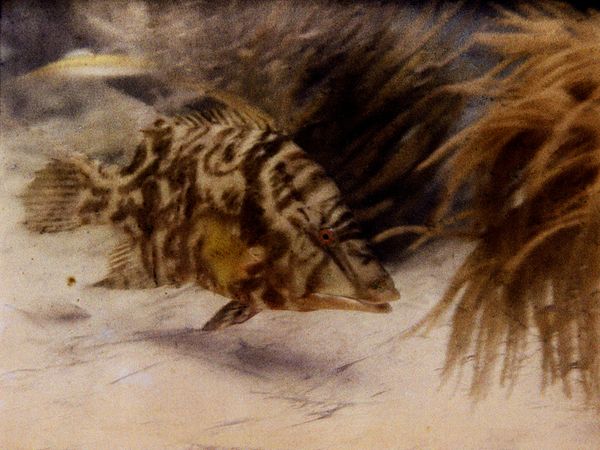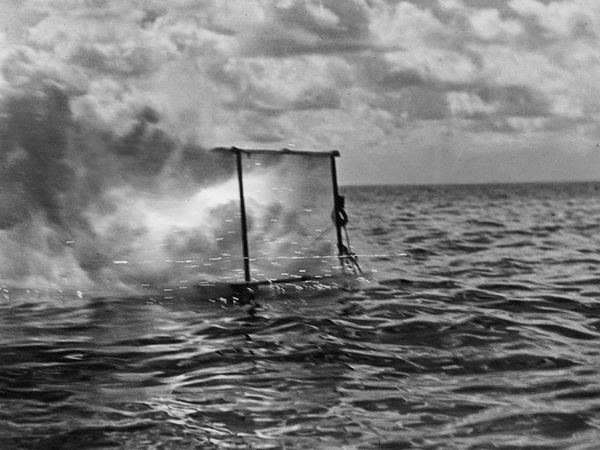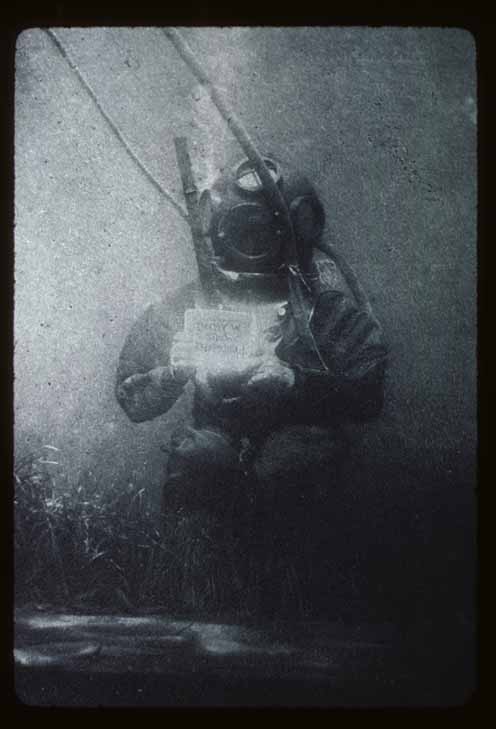© Louis Boutan
The image above is known as the world’s first underwater photograph – it is said that the model was so excited that he held the identification plate upside down! It was made in 1893 by the French zoologist Louis Boutan by using a magnesium flash.
Yet little is known that the Frenchman Louis Boutan didn’t actually take the first underwater photograph. According to John F. Brown (British Journal of Photography, 9th August, 1985) the incredible achievement goes to Dorset solicitor and natural historian William Thompson, who took the first underwater photograph in 1856! In February that year, Thompson, assisted by his friend Mr Kenyon rowed out a short distance into Weymouth bay and lowered a box containing a ‘5 x 4’, plate camera into the sea and operated the shutter from a boat to expose the plate to create the first ever underwater photograph.
Thompson’s box had a plate glass front and a wooden shutter operated from the surface with a length of string. The camera was prefocused at 10 yards, a distance Thompson later acknowledged was too great. A portable darkroom tent, on shore, was used to prepare the glass plate negative. The film holder was then put into the camera, the darkslide withdrawn, the lens uncapped and placed in the box with the shutter closed. Next the whole contraption was attached to an iron tripod and taken out by boat to be lowered to the seabed.
The next problem concerned the camera itself. Thompson’s camera took a plate measuring 5 inches by 4 inches, which he prepared using the collodion process. This meant that the liquid chemical had to be poured on to the plate, and be exposed and developed all within a matter of an hour or so. Following the procedure usual at the time, Thompson set up a small tent, on Weymouth beach, and inside it prepared a plate and put it in his camera. He then, under cover of a black cloth, placed the camera in the box, making sure that its lens was against the plate glass, and screwed on the back, to then lower it into the sea.
For the site of his experiment Thompson chose what he described as “a nook in the bay of Weymouth which is bounded by a ridge of rocks (where the area within is of sand and boulders and thickly clothed with many species of seaweeds”. Thompson and his friend Kenyon, having rowed out a sufficient distance from the beach, lowered the box into 18 feet of water. When he was sure that the apparatus was standing upright on the bottom, he pulled the string that raised the hinged shutter. Thompson made two attempts that day. For the first he allowed an exposure time of five minutes but found that the plate having been developed registered nothing.
Even though the depth was estimated to be no more than eighteen feet, the pressure was such that water forced its way through the joints and into the box. Like many of us in similar situations, Thompson despaired of obtaining an image. After washing the plate in fresh water and developing it, he was, however, pleased to note that seawater was not as injurious as he feared. The seawater left only a line at the height which it had reached during the exposure. John Brown considers Thompson’s photograph a ‘gallant and innovative failure, it being difficult to decipher‘. But it was the first, and beat Boutan by thirty seven years.
For his second attempt he doubled the exposure time. Although by then the light had deteriorated, he obtained a reasonable satisfactory negative, from which he made a print on which it was possible faintly to discern the outlines of boulders and seaweed. Water had leaked into the camera but this, Thompson was pleased to see, had not seriously affected the quality of the picture. He also noted with surprise that the image had not been inverted, and came to the conclusion that the thick plate glass in front of the lens must have acted as a reversing mirror.
Thompson later designed a better apparatus, but he then lost interest and pursued the matter no further. His friend William Penney of Poole, who was a chemist, and a naturalist of some note, persuaded him to send an account of his experiment to be printed in the Journal of the Society of Arts, otherwise there would probably have been no record of it in existence today.
In 1926 Dr. William Longley and National Geographic’s Charles Martin took this photo of a hogfish off the Florida Keys, and brought in a new generation of underwater photography — this time in color. They needed extremely specialized gear to take the shot, and were faced with a major problems in order to get enough light to properly expose. So, how did they manage to produce a great burst of light projected into the ocean? They ended up relying on pounds of magnesium flash powder, floating in a boat on the surface.

While the pair were diving, they left a raft laden with the explosives floating above. When they took the shot, the camera shutter tripped a battery on the raft, igniting the magnesium powder, and illuminating the water down to 15 feet. Considered pretty hardcore photography, by the standards of any day.

Information: National Geographic/ The First Underwater Photographs








